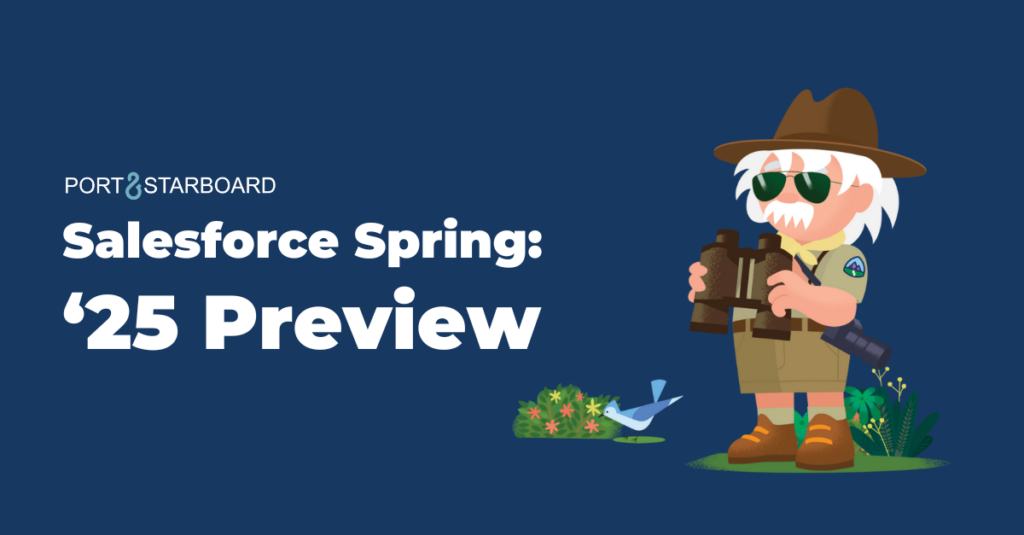Salesforce is known as the world’s #1 CRM application. This powerful customer relationship management solution is intuitive, flexible, scalable, and complex – and it’s constantly getting better.
You can oversee business operations, sales, marketing, finances, and more with Salesforce. Connect every department to create a cohesive system. Meet your clients where they are by giving each team a complete view of every customer. Increase revenue, delight and retain your customers, and identify new growth opportunities.
While Salesforce has the potential to help grow your business exponentially over time, you need to prepare before implementing to set your business up for ongoing success. If you don’t, your Salesforce implementation will probably fail (like most CRM projects).
In this guide, we’ll cover the ten crucial steps to take before your Salesforce implementation. Following this process will empower your team to set the right expectations, adapt to necessary changes, and establish the groundwork to facilitate growth and efficiency across your organization.
Once you set the proper foundation, the possibilities are limitless.
Why do you need to prepare for a Salesforce implementation?
Businesses often implement Salesforce to manage complex business operations. Without a clear vision and roadmap, coordination across different departments, sufficient training, and proper support, your team won’t have the confidence or knowledge to ensure a successful rollout.
How long does it take to implement Salesforce?
On average, it takes a business three to four weeks to implement Salesforce. However, this can vary significantly based on an organization’s needs and goals. If you require a complex setup with lots of customization, your Salesforce implementation could take months to complete.
10 Critical Steps to Take Before Your Salesforce Implementation
1. Know your vision.
Why do you want to implement Salesforce? What do you hope to achieve over the long term? How do you define success?
Your vision is how you see the future. It should encompass your deepest-held values and the reason your business exists. Identifying your vision – the long-term, overarching goal for your company – will remind you of what matters most throughout your project.
2. Get all stakeholders on board.
Make sure everyone relevant to the project – from the end-users to top management – is involved from the beginning. All stakeholders (or representatives from each stakeholder role) should participate in the preparation phase, implementation, and ongoing management.
Key stakeholder roles to assign:
- The key decision-maker: An individual with authority to make executive decisions on various aspects of the project (e.g., budget and timeline)
- A project manager: Someone to keep your project on track and ensure each team continues moving forward toward your organization’s common goals
- Team leads: People nominated to represent their teams and advocate for the end-users in their department (e.g., Marketing, Sales, Customer Service)
- End-users: Individuals who will use the system regularly (internal employees or clientele)
3. Define your goals and set your budget.
Involving each of your primary stakeholders, set goals for how you want Salesforce to change your business and help you realize your overarching vision. Your goals should be specific, measurable, attainable, realistic, and time-based (SMART). Here are some questions to get you started:
- What pain points or challenges do your team and end-users face?
- What are the most time-consuming tasks?
- How can you simplify your workflows?
- Where are the communication blocks?
- What do you hope to achieve by implementing Salesforce?
After goal setting, you can work backward to identify the steps you must take to reach your goals while working within your budget. Consider these factors when setting your budget:
- Licensing costs
- Software ownership or leasing costs
- Consulting costs
- Training costs
- Number of users
- Data migration costs
- Customization costs
- Ongoing support costs
4. Establish a timeline.
Once you’ve defined your goals, you can determine your timeline for reaching them. Remember that a Salesforce implementation can take four weeks or more (if you require customization).
Consider how the implementation will impact current projects. Also identify who needs to be involved in the implementation process and ensure their availability.
On your timeline, you can include milestones you want to hit along the way for your implementation to be successful. Having a vision, goals, and a clear timeline will give your company an overview of project expectations.
5. Conduct a needs analysis.
This is where you nail down what you need to optimize Salesforce and make it work for your business. Only choose the functions that will help you achieve your goals and support your vision. Again, involve your stakeholders.
Collect a list of requirements – or desired outcomes – from individuals or teams. Then bring everyone together to vet the list. You can sort requirements into high, medium, and low–priority buckets. Your high-priority items are the ones you need to implement Salesforce successfully. Low-priority items are things you’d like to include for more convenience but don’t require.
Note: This process can be challenging for many businesses to perform on their own. A Certified Salesforce Consultant can help you conduct a needs analysis to identify your top priorities for a successful implementation. Based on your requirements, Salesforce Consultants can identify what is possible with Salesforce “out of the box” and which desired features would require more time and customization to achieve. They will create a “use case” document and help you identify customizations that will match your requirements.
6. Hire the right people.
Next, you’ll want to leverage the experience of experts to ensure your Salesforce implementation is a success. You can hire or source a Certified Administrator who will help you identify what you need and use best practices and in-depth system knowledge to make it happen.
You also have the option of hiring an entire team of experts – project managers, consultants, and developers – to implement Salesforce. They can help you:
- Integrate external systems
- Improve data management
- Train your team
- Customize your system to meet your unique needs
- Provide ongoing support and maintenance
Note: You may want to move this step to earlier in the process, depending on your CRM and Salesforce experience.
7. Develop a project methodology.
Most businesses choose to implement Salesforce in one of two ways:
- Sequential (waterfall) method: This is a traditional approach to project implementation, where you follow a sequential timeline to reach your goals. The entire system is built, tested, and then implemented to go live.
- Iterative (agile or “scrum”) method: Build out your system using a cyclical approach. Break down the project into smaller “mini” projects. Each mini-project is built and tested before going live to prepare different parts of the system individually. This method can minimize problems you might face using a more traditional approach.
Your Salesforce Administrator can advise you on which method is better for your situation. It will likely depend on whether you’re implementing Salesforce for the first time or upgrading.
8. Train and prepare your team.
Before implementation, make sure to prepare your employees (or clients) for the adjustments required to integrate Salesforce. They should be trained to use the software using best practices.
Also explain why you’re implementing it (going back to your vision and goals) so everyone is on board. Don’t forget to provide additional training every time you make an upgrade.
9. Avoid overcomplicating the process.
To avoid overwhelm, keep your implementation as simple as possible. Develop a workflow that your employees want to use – one that makes their lives easier. In the end, Salesforce should support your efforts, not complicate them.
If this is your first implementation, start with basic functionality and build from there. You can always add more features and customizations once you have a good handle on the basics. Implementing complex functionality too soon could overwhelm your team. They might even try to avoid using Salesforce altogether.
Here are a few more insider tips to help you keep things simple:
- Keep a list of enhancements and follow-on items to avoid scope creep.
- Keep track of features you’d like to implement later (in Phase 2 and beyond).
- Keep your end-users in mind. If they’re required to fill out numerous fields, they’ll less likely adopt and use Salesforce. Most companies want to make this platform their source of truth, which only works if people use it.
10. Set up ongoing support.
Before implementation, prepare for ongoing support. You’ll need someone (or a team) to take care of enhancements, bugs, user problems, and new project requirements as they arise.
If you don’t have the budget for Salesforce’s Premier Success Plan, consider working with a fractional Salesforce Administrator. Port & Starboard has an entire team of Salesforce-certified individuals to provide customer and project support and ongoing maintenance. We can also recover a failing Salesforce implementation or customize the platform to suit your needs.
Need help with Salesforce CRM implementation?
Port & Starboard can help you tackle everything from strategy and implementation to providing ongoing support and maintenance. You can partner with us for a fraction of the cost.
We’re here to supplement your team with what you need – no more, no less. Our goal is to deliver solutions that move your business forward.





